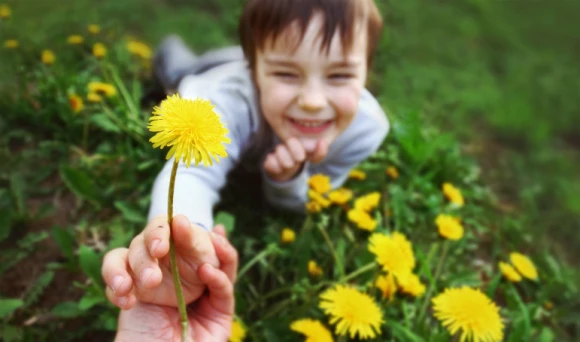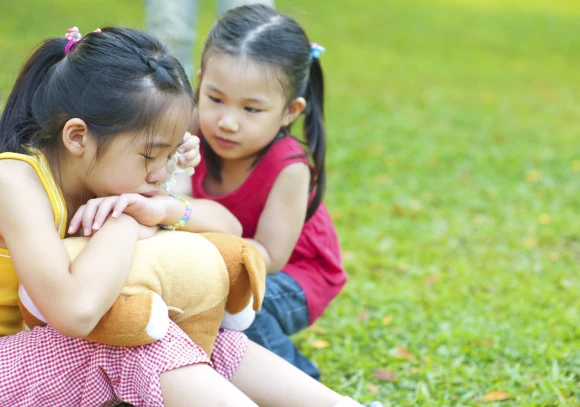Time Required
As little as 10 minutes. This practice can be done when you notice your children experiencing any kind of strong emotion.
How to Do It
When our children feel anger, sadness, or other intense emotions, we might be inclined to distract or redirect them away from their discomfort. But this isn’t always the best strategy. Research on attachment—the unique loving bond between children and their caregivers—suggests that a key part of developing secure and loving relationships is spending time with your children to support their experiences with their emotions.
Practice these three steps to help strengthen your bond with your children:
- Heighten awareness: When helping children recognize their emotions, show your curiosity about their experience rather than imposing feelings on them. For instance, say, “I’m wondering if you’re upset?” rather than declaring, “You’re upset.” Be both humble and inquisitive. This approach shows your children that you acknowledge that their emotional experience is personal and that you are open to understanding them.
- Name it: Encourage your children to talk about what they are feeling, then take a moment to reflect what they’ve told you and give a possible name to the emotion. You can say, “It sounds like you’re feeling sad,” or “It sounds like you’re frustrated.” By giving them an opportunity to put their internal experiences into words, you help them cultivate a bigger emotion vocabulary and show them that expression is one way to regulate difficult feelings.
- Explore together: Validate your children’s emotional experience. This can be as simple as saying, “That sounds like it would be frustrating.” Help them make sense of any aspects of their experience that are confusing to them, such as mixed emotions. For example, kids can feel happy a friend won an award and, at the same time, sad because they wanted the award. Show them you understand by matching their emotions with your voice, face, and touch. You can share a smile if your child is excited or hold their hand if they are nervous. These non-verbal expressions can help your children recognize and make sense of their own emotions.
Why You Should Try It
Securely attached children tend to have higher self-esteem, show better self-control, and perform better in school. Children who experience more loving relationships with their parents also tend to be more compassionate and helpful toward others later in life. The empathy, love, kindness, and compassion that your children develop can support them in building positive relationships with others.
Beyond interpersonal relationships, love has lasting benefits for our health and growth—while people who grow up without loving bonds may experience immune system dysfunction and chronic illness.
Why It Works
Children develop secure attachments when they have benefited from a caregiver’s enduring love—so much that they “have confidence in the possibility of goodness.” In other words, because they have received consistent care, warmth, and sensitivity in the past, they believe that others will respond to their vulnerability with compassion in the future.
In addition, parents who are attuned to their children model caring behavior that their children can embrace and imitate. When parents are responsive to their children’s emotions, children learn to become more aware of their own feelings.
The ability to be agile with their emotions allows children to better support others who are in distress because they don’t become overwhelmed by other people’s pain. With a greater understanding of emotions, securely attached children can empathize more skillfully and, in turn, show care, love, and compassion to others.
Evidence That It Works
Powell, B., Cooper, G., Hoffman, K., & Marvin, B. (2014). The Circle of Security intervention: Enhancing attachment in early parent-child relationships. New York: Guilford Press.
This manual explores concepts used in the Circle of Security intervention, a program for cultivating secure attachments between parents and children. It provides parents a roadmap to observe, identify, reflect on, and respond to their children’s core needs, including a secure base from which to explore the world and a safe haven to return to for comfort. The authors offer guidance on how to provide comfort to children by helping them process and understand their own emotions.
Hoffman, K. T., Marvin, R. S., Cooper, G., & Powell, B. (2006). Changing toddlers' and preschoolers' attachment classifications: The Circle of Security intervention. Journal of Consulting and Clinical Psychology, 74, 1017-1026.
Child-caregiver pairs participated in the Circle of Security intervention. The results showed that the intervention was effective in changing children’s attachment styles from non-secure to secure attachments.
Andrews, E. (2019). A parenting intervention for middle childhood: An expansion of a Circle of Security intensive individual protocol. The Educational and Developmental Psychologist, 36(1), 27-31.
This case study showed that the Circle of Security intervention previously used with caregiver-child pairs up to preschool age can also be effective with older children.
Sources
Robert S. Marvin, Ph.D., University of Virginia School of Medicine







Comments
and Reviews
Aisha
A great practice that can be used again and again.
Ryan
Moneypenny
alexandra duran
Sheila Speigelhalder
brendasl@comcast.net
A Loving Space for Kids' Emotions is a priceless gift we can give our children. I am a licensed clinical social worker and have been passionate about validating children's feelings since my first parenting class 30 years ago. This approach de-escalates strong emotions in the short term and builds strong, healthy relationships in the long term. It has had such a powerful and positive impact on my parenting, I recently published a children's book, entitled, "What I Really Want to Hear, A collection of short stories about managing feelings," for families to read together and learn together. Here is the link if you want to check it out! My daughter did the illustrations! https://www.amazon.com/What-Really-Want-Hear-collection/dp/B09QK23DMW/ref=tmm_pap_swatch_0?_encoding=UTF8&qid;=&sr;=
The Greater Good Toolkit
Made in collaboration with Holstee, this tookit includes 30 science-based practices for a meaningful life.
The Greater Good Toolkit
Made in collaboration with Holstee, this tookit includes 30 science-based practices for a meaningful life.